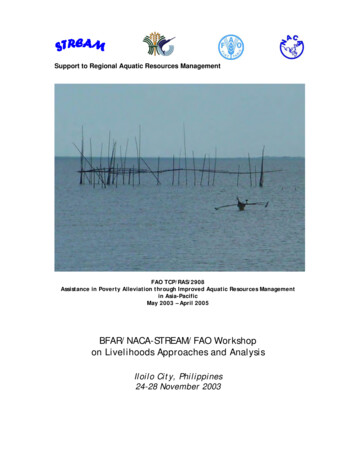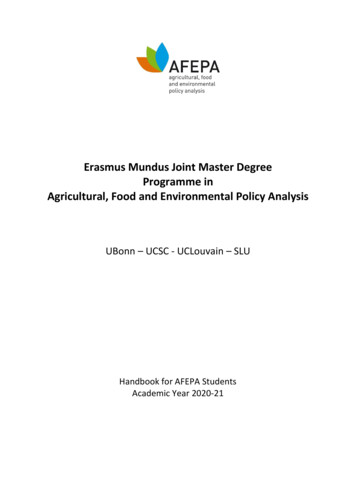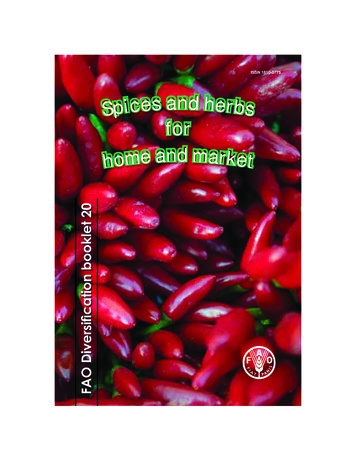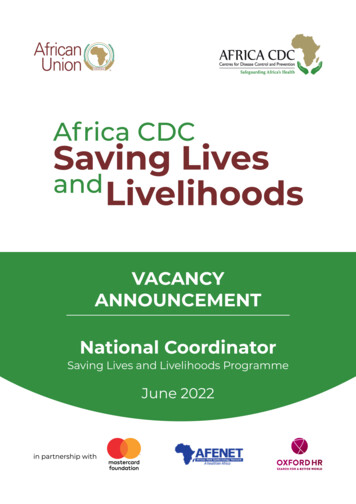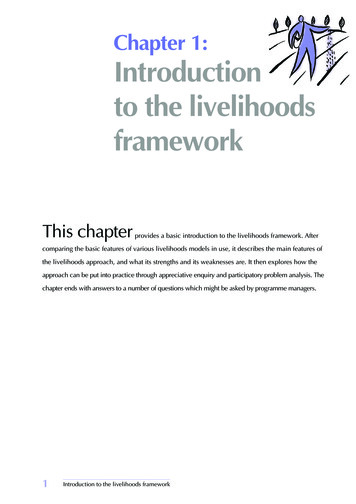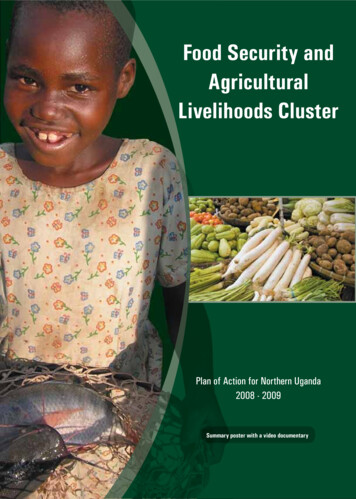
Transcription
Food Security andAgriculturalLivelihoods ClusterPlan of Action for Northern Uganda2008 - 2009Summary poster with a video documentary
Food Security and AgriculturalLivelihoods ClusterPlan of Action for Northern Uganda2008 - 2009FSAL cluster member contribution:Ministry of Agriculture, Animal Industry and Fisheries (MAAIF)Office of the Prime Minister (OPM)ACF, ASB, AHA, AAH, ACDI, ACTED, AVSI, ADAN, CRS, Caritas, CD, CLIDE, CONCERN, CoU, DRC, ICRC, IRC, IIRR, GAA, GOAL, FIDA, LWF,NAADS, NARO, KDLG, NRC, MADEFO, MEDAIR, Mercy Corps, PU, RALNUC, TEMEDO, TEDDO, SCIU, UNHCR, URCSm OXFAM, WFP, VSF.Financial support:European Commission, USA, Belgium, Sweden, Norway, UK, ECHO, Japan, Canada, Switzerland, Netherlands, CERF, Spain, Italy, France,Denmark.Coordinated by FAO
ContentsAcknowledgments. ivAcronyms. vEXECUTIVE SUMMARY .11. INTRODUCTION: OBJECTIVES AND ORIGINS OF THE PLAN OF ACTION .22. SITUATION ANALYSIS .3Northern Uganda in national context .3Regional situation, problems and scenario analysis . 4Introduction .4Karamoja region.5Teso, Lango and Acholi sub-regions.9West Nile region.153. RESPONSE PLAN .18Introduction .18Structure of the response plan .19Programme 1 - Karamoja .20Programme 2 - Teso, Lango and Acholi.23Programme 3 - West Nile.274. RISK ANALYSIS .295. LOGICAL FRAMEWORK, MONITORING AND EVALUATION AND MANAGEMENT .30Introduction and logical framework .30Plan of Action monitoring, evaluation and reporting . 32Management arrangements.33BIBLIOGRAPHY .34ANNEXES .36ANNEX 1: relationship between the Plan of Action and key Government plans and strategies . 37ANNEX 2: “What if” risk analysis .42ANNEX 3: Regional/sub-regional Plan of Action development workshop participants . 43ANNEX 4: NGOs implementing food security interventions and their areas of operation. 47ANNEX 5: Household livelihood security .50iii
AcknowledgementsThis cluster plan of action is the result of three intensive months of collaboration betweenall stakeholders involved in Food Security and Agricultural Livelihoods activities in NorthernUganda.Whilst FAO Uganda had overall responsibility for developing and guiding the preparation of thispublication, technical expertise and contribution from the different organisations was paramountto the revision of the PoA.We would like to express our appreciation to all 131 individuals, UN agencies, NGO, CBO staffmembers, civil servants who spared time to contribute to the four different brainstormingworkshops that were organized at field level in July 2007. In addition, we would like to thank theseveral hundred men women and youth who participated in the community validation exercisesthat took place across Karamoja, Teso, Lango, Acholi and West Nile in August 2007.iv
AcronymsACFAction Contre la FaimADANApac District Agricultural NetworkASBArbeiter Samariter BundASTUAnti Stock Theft UnitsAVSIAsozatione di Voluntary per il Sivelupo InternationaleBXWBanana Xanthomonas WiltCAHWCommunity Animal Health WorkerCAPConsolidated Appeal ProcessCARECooperative for Assistance and Relief EverywhereCBOCommunity-Based OrganisationCBPPContagious Bovine Pleuro PneumoniaCBSDCassava Brown Streak DiseaseCCPPContagious Caprine Pleuro PneumoniaCERFCentral Emergency Relief FundCEWARNConflict Early Warning and Response MechanismCFSAMCrop and Food Supply Assessment MissionsCFWCash For WorkCMDCassava Mosaic DiseaseCMRCrude Mortality RatesCOUDiocese of Kitgum-Church of UgandaCPAConcern Parent’s AssociationCRSCatholic Relief ServicesDACDevelopment Assistance CommitteeDANIDADanish International Development AgencyEACMD-UGEastern African Cassava Mosaic Disease – Ugandan variantECHOEuropean Commission Humanitarian Aid OfficeEFSAEmergency Food Security AssessmentEUEuropean UnionEVIExtremely Vulnerable IndividualFAOFood and Agriculture Organization of the United NationsFEWS NETFamine Early Warning System NetworkFFAFood For AssetsFFSFarmer Field SchoolFFWFood For WorkFHIFood for the Hungry InternationalFSALFood Security ClusterFTSFinancial Tracking SystemGAAGerman Agro ActionGAMGlobal Acute MalnutritionGDPGross Domestic ProductGIEWSGlobal Information and Early Warning SystemGOUGovernment of Ugandav
AcronymsviHIV/AIDSHuman Immunodeficiency Virus/Acquired Immunodeficiency SyndromeHoAHorn of AfricaICPACIGAD Climate Prediction and Applications CentreICRCInternational Committee of the Red CrossIDPInternally Displaced PersonIKIndigenous KnowledgeIRCInternational Rescue CommitteeKDFAKitgum District Farmer’s AssociationKIDDPKaramoja Integrated Disarmament and Development ProgrammeLEWSLivestock Early Warning SystemLRALord’s Resistance ArmyLWFLutheran World FederationM&EMonitoring and EvaluationMAAIFMinistry of Agriculture, Animal Industry and FisheriesMoHMinistry of HealthNAADSNational Agricultural Advisory ServicesNCANational Competent AuthorityNGONon-Governmental OrganisationNRCNorwegian Refugee CouncilOECDOrganisation for Economic Co-operation and DevelopmentOCHAOffice for the Coordination of Humanitarian AffairsOPMOffice of the Prime MinisterPEAPPoverty Eradication Action PlanPLWHAPerson Living with HIV/AIDSPoAPlan of ActionPPRPeste des Petits RuminantsPRDPPoverty Reduction Development PlanPRROProtracted Relief and Rehabilitation OperationRALNUCRehabilitation of Agricultural Livelihoods ComponentRDARecommended Daily AllowanceRDPRecovery and Development Programme of the World BankREINReintegration, Employment and Income Development for the NorthUFNSUgandan Food and Nutrition StrategyUNUnited NationsUNAIDSThe Joint United Nations Programme on HIV/AIDSUNHCRUnited Nations High Commission for RefugeesURCSUganda Red Cross SocietyUSAIDUnited States Agency for International DevelopmentVSFVétérinaires Sans FrontièresWFPWord Food ProgrammeWHOWorld Health OrganizationWVIWorld Vision International
Executive SummaryThe Northern region, which is identified by official statistics as trailing behind the central, westernand eastern regions in terms of poverty reduction, has experienced multiple and severe shocksincluding drought, civil war lasting for over 10 years and loss of cattle to Karamojong raids.The signing of a peace agreement between the Government of Uganda (GOU) and the Lord’sResistance Army (LRA) and initial implementation of terms bears hope for Northern Uganda.It is in this context that the 2008/09 Cluster Plan of Action (PoA) for Northern Uganda has beendeveloped. The PoA is the result of a three month process of field consultation and analysis onfood security and livelihoods with national and international NGOs, UN agencies, governmentrepresentatives and civil society.In terms of scope of interventions, the PoA aims to create and promote the conditions foraddressing root causes of livelihood erosion by linking short term/immediate actions with longerterm measures and considerations. Thus the Plan proposes a set of balanced responses thataim to protect, rehabilitate and diversify the livelihoods of pastoralists, agro-pastoralists andfarmers in northern Uganda. In that respect, the document is meant to complement long-termdevelopment strategies and focuses on the range of emergency, recovery and rehabilitationinterventions needed for the whole of the North (Karamoja, Teso, Lango, Acholi and West Nile).Implementation of the PoA will be through partnerships between government, UN agencies,NGOs, civil society and the private sector.The selected option is based on a pro-poor and community self-reliance approach as the mostsustainable way to achieve productivity growth and improve use and access of natural capital. Inareas with low agricultural potential (Eastern Uganda – Karamoja), livestock systems are the basisof livelihoods. In areas with higher agricultural potential (Northern and Nile provinces), wherefarmers could pursue high-value livelihood opportunities, use of improved technologies will besupported to raise productivity growth.The goal of the PoA is to improve the livelihood security of rural households in NorthernUganda.The anticipated outcome sets the medium-term scenario on which the programme is expectedto make an impact and is to support and stabilise food security of rural households in NorthernUganda.The outputs of the PoA were designed to have a rapid impact, building on existing andsuccessfully implemented approaches and systems.Output 1 – Increased food availabilityOutput 2 – Reduced vulnerability to food security riskOutput 3 – Better access to food through safety netsThe outputs of the PoA will be achieved through three pronged and regionalised programmes.Programme 1 - Karamoja: Diversifying and strengthening of pastoral and agro-pastorallivelihoodsProgramme 2 - Teso, Lango, Acholi: Support to the return processProgramme 3 - West Nile: Improving self-reliance of refugees, IDPs and host communitiesIn addition to this narrative section, the Food Security and Agricultural Livelihoods (FSAL) clusterhas developed a 20-minute video document to illustrate the main activities undertaken toimplement the above identified programmes.1
1. Introduction: Objectives and Origins of the Plan of ActionThe Plan of Action (PoA) is a planning tool conceived to concretely and efficiently set a technicallyappropriate framework for interventions by the Uganda FSAL agencies in Northern Uganda in the2008/09 period. It is a ‘live’ and dynamic document reflecting the premise, progress, and resultsof a crisis management programme cycle.Conceptually, the PoA aims to contribute to the formulation of the Consolidated Appeal Process(CAP) in terms of information and targeting. Alternatively, in the absence of an institutional tool,the PoA can sustain the appealing process as well as advocate for a ‘connectedness’ between theemergency and development assistance.Operationally, the realisation of the PoA is achieved through the existing food security andagricultural livelihoods interagency cluster and this framework have the buy-in, ownership andsupport of local and central Government, communities, national and international NGOs, UNagencies and donors. The interagency cluster - co-chaired by the Ministry of Agriculture, AnimalIndustry and Fisheries (MAAIF), FAO and WFP - provides a forum for information exchange andconsensus building, ultimately leading to an enhanced response and a more balanced allocationof resources.The PoA’s structure follows the sequence of a logical framework progressing from SituationAnalysis to Response Options Analysis, Response Planning, Response Implementation, andMonitoring and Evaluation. In order to effectively reflect the changing context of the North, thePoA will be periodically updated to incorporate additional information and adjust the responseto the new situation whenever required. Additional video documents will be developed to detailimplementation methodologies for specific activities selected on best practices considerations.The 2008/09 Plan of Action for Northern Uganda has been designed to tackle some key aspects offood insecurity for rural-poor communities in post-conflict situation areas (Northern Uganda) andmarginal productive areas (North-Eastern Uganda), by using and building on existing bottom-upand community-based approaches.Furthermore, the document has been developed as a complementary livelihood, food securityand vulnerability reduction tool to link the 2008 Uganda CAP with longer-term strategicdocuments. In particular, the 2008/09 PoA links to the Poverty Eradication Action Plan (PEAP), thePoverty Reduction Development Plan (PRDP), the National Agricultural Advisory Services (NAADS)strategy for Northern Uganda, the Uganda Food and Nutrition Strategy the Karamoja IntegratedDisarmament and Development Programme (KIDDP) and the draft transition strategy for the LRAaffected North.Finally, the PoA also complements the UN consultative process for the Horn of Africa initiativewhich was initiated at the request of the UN Special Humanitarian Envoy for the Horn of Africa,Kjell Magne Bondevik, in November 2006. As an expression of its commitment to the Horn ofAfrica process, GOU has given its support to the development of this PoA for the Food SecurityCluster, and the PoA itself draws on the recommendations and proposed actions provided by theUganda Horn of Africa Report1.12Horn of Africa Consultations on Food Security, Uganda Country Report (Ministry of Agriculture Animal Industryand Fisheries, June 2007).
2.Situation AnalysisNorthern Uganda in national contextCompared to the rest of sub-Saharan Africa,Uganda has performed better since 1990 inreducing the percentage of its people underthe poverty line. There has been a significantdecline in absolute poverty between 1992(56%) to 2003 (38%). Further to Uganda’scredit, at the end of 2005, the adult nationalHIV/AIDS prevalence rate was estimated at6.7%, a huge reduction from the peak of30% in 1988.Key facts Population: 28.2 million GDP (PPP) per capita: US 1 800 Population below poverty line: 35% Labour force by occupation: agriculture 82%, industry 5%,services 13% Total land area: 236 040 sq km, bordering Democratic Republicof the Congo, Kenya, Rwanda, the Sudan, and Tanzania Total arable land: 21.6% Life expectancy: male: 52 years, female: 54 years Literacy rate: male: 79.5% , female: 60.4%In general terms, Uganda is regarded as self Human Development Index: 144/177sufficient in food production. However, at(Source: UN; World Bank)any given time, 40% of Uganda’s population(median age 14 years) lacks reliable accessto sufficient healthy food and 39% of children under age five are stunted. Agricultural andpopulation statistics available indicate that per capita food production in early 2000 was over40% less than what it was in 1970. Uganda’s rapid population growth (2.5% per annum) presentsa continuing challenge to future economic growth and poverty reduction efforts. Moreover, thecountry suffered massive terms of trade shocks when international coffee prices fell. As a result,per capita incomes fell sharply during the 1980s and early 1990s.In comparison to the rest of the country, the Northern districts lag behind in terms of humandevelopment indicators. Most welfare indices are poor in the North largely because of thepresence of conflict and weak state institutions. The PRDP gives the following comparisons: Income poverty: Income poverty has declined less than in other regions of the country. Theproportion of poor people in the North (defined as those unable to meet their basic needs)declined from 72% in 1992 to 60% in 1997, but increased again to 64% in 2002. Literacy: There are wide regional disparities in literacy rates. In the Central region, 80% ofadults are literate whilst in the Western region the figure is 74%. In Eastern region, the figureis 63%, and in Northern region it is 56% (with 42% of adult females being literate). Primary education: The majority of Northern districts are lagging behind in terms of pupils’ability to complete primary education and service provision is worst of all in the Karamojasub-region. Water and sanitation: Depending on the season, in Kotido, Pader and Yumbe districts,between 20% and 40% of households are estimated to have clean water supplies whilst themajority of the other districts in the North have an estimated coverage of 40% (rainy seasons)and 60% (dry seasons) which is close to the national average. Health: Infant, child and maternal mortality remain high nationally having increased between1995 and 2000. Disaggregated by region, the mortality rates were much higher in the North.The rates for Gulu, Kitgum, Pader are crude mortality rates (CMR) of 1.54/10,000 and U-5MR 3.18/10000 (July 2005 MoH) and CMR for Karamoja is 3.9/10,000 (MoH August 2004). One of the factors affecting poor health and income indicators is the increase in femalefertility rates HIV/AIDS: Although Uganda has seen HIV prevalence fall from an average of 18% in 1992to 6.4% in 2005, HIV/AIDS prevalence in conflict-affected areas of North-Central Uganda(Acholi, Teso and Lango) is still high at 8.2%. Prevalence amongst women is higher thanmen, 9% and 7.1% respectively (Source: PRDP – second draft page 12).3
Regional situation, problem and scenario analysisIntroductionUsing a conflict analysis framework, Northern Uganda can be divided into three broad situations,as shown in the following table:Table 1: Northern Uganda districts in a conflict frameworkConflict statusSub-regions and districtsPost Conflict: armed rebellion ended, resumptionof normality and stabilisation/developmentinvestments neededNorth West - West Nile sub-region: Arua /Koboko / Maracha, Adjumani, Moyo, Nebbi,YumbeCessation of hostilities/early recovery: whilstpeace agreement yet to be signed, situationlargely stabilised, investments needed to supportsocial, economic and political rebuildingNorth Central – Lango, Acholi, parts of Tesosub-regions: Gulu / Amuru, Kitgum, Pader,Lira / Dokolo / Amolatar, Apac /Oyam, Soroti,KaberamaidoLawlessness and underdevelopment: armedcivilian population and destruction of propertythrough inter-ethnic conflicts with spill overeffects, stabilisationand developmentinvestments neededNorth East - Karamoja and part of Teso subregion: Moroto, Kotido / Abim / Kaabong,Nakapiripirit, Katakwi/Anuria.Source: Adapted from PRDP second draft (March 2007)The details of the food security and livelihood situation analysis for the three regions targeted bythe PoA are provided in the following regional situation analysis section. However, a summarisedvisualisation of the key food security problems in Northern Uganda is presented below in formof a diagram, called a “problem tree”. The objective of the problem tree is to help analyze andclarify cause–effect relationships.Problem treeEFFECTSUn-sustainablelivelihoodFood insecurityLimited foodavailabilityHigh exposure todisaster risksLimited access to foodDependency onHumanitarian aidLow crop/livestockproductivity andproductionPost harvestlossesOver-dependencyon traditionalfarmingLack ofknowledgeDroughts, floods,water loggingUnreliablerainfall patternsCAUSESNatural Hazard4Low seed qualityLow levelof educationInsufficientextension servicesHigh incidence ofCrop/livestockpest and diseaseLimited access tocrop/livestocktreatmentsPoor infrastructureand feeder roadsInsufficient public service provisionEnvironmentaldegradationReduced mobilityfor pastoralistsLoss of physicalCapital –Lowfarming inputsPhysicalinsecurityErosion of copingstrategiesLoss of naturalCapital – Landaccess issueLow capacity toengage in postconflict rehabLoss of socialCapital –Social fragmentationLoss of financialCapital –No cash/No loansPopulationmovementConflict environmentDisruptedeconomyLoss of HumanCapital –Knowledge/skills
Karamoja regionFood security situationKaramoja can be broadly divided into three main agro-ecological zones - running north to south- which cut across the main ethnic groups in the region. The zones are delineated with referenceto a spectrum in which settled farming is at one end and pure transhumance pastoralism at theother. In between, there is a zone which is commonly described as “agro-pastoral”, although inreality - with the possible exception of the Pokot ethnic group2 - all farming systems in Karamojaare agro-pastoral to some degree. The following map shows where these three zones lie:Figure 2: Karamoja Livelihood ZonesLIVELIHOOD ZONES OF UGANDALEGENDN050KilometersFishing-CassavaApujan ClayClay LoamDry BeltHigh RF wet beltModerate RFSandy LoamWet g-Salt ExtractionHighland CultivationLowland kPastoralUrban/Peri-urbanLoams-High RFSandy-Low RFSandy Loam-High RFCrop ProductionFishingForestRoot CropForest Crop FarmBanana-CerealTea-Annual mHorticulturalLivestockNational iculturalAgropastoralMid Plateau TobaccoThe Highland CoffeeThe Highland PlateauThe Lowland le-RiceCattle-SorghumPigeon peas-CassavaSorghum-CattleFEWS NET June 2005The 2002 census gave a total population of 957,245 for the region (50% female). The problem offood insecurity in Karamoja has been dissected and measured many times and the latest studiesconfirm its persistence in the region.An Emergency Food Security Assessment (EFSA) undertaken by WFP in Karamoja in April thisyear classified 27% of the sample as “food insecure”, with a further 47% as “moderately foodinsecure”. The assessment was undertaken in all five districts of the region. The highest levelsof “food insecurity” were found in the Dodoth and Jie counties in Kotido and Bokora Countyin Moroto. Taken together, the “food insecure” and “moderately food insecure” categoriesaccounted for 70% or above of the sample in six of the nine counties surveyed (and over 80% inthree of them).2The Manyattas of the Pokot are located in the South Eastern corner of the region.5
Using a different methodology, a survey commissioned in October 2006 and published in June2007 also found very high levels of food insecurity in the three districts of Abim, Kaabong andKotido3. Using a combination of a household dietary diversity index and a household grainavailability index, the study classified households into four groups:1.2.3.4.Households with adequate dietary diversity and grain availability Food SecureHouseholds with inadequate dietary diversity but adequate grain availability VulnerableHouseholds with adequate dietary diversity but inadequate grain availability VulnerableHousehold with inadequate dietary diversity and grain availability Food InsecureDepending on the district, between 47% and 64% of the sample were classified as “food insecure”with a further 42-29% classified as “vulnerable”.Underlying these figures is a complex picture of conflict, poverty and environmental factors.Over the centuries, the pastoral peoples of these areas have developed a highly sophisticatedapproach to sharing scarce water and grazing land in an unstable, ecological system. Cattleraiding, to restock decimated herds, was a traditional part of this system, but so was shared landuse between different ethnic communities. Today, however, violence in the region has reachedunprecedented proportions. It has changed in nature, scale, and dimension due to a number offactors, including: the proliferation of automatic weapons, policies of neglect and interferencefor political gain, high youth unemployment, increased demand for and decreased productivityof land, a long-term pattern of desiccation, and reduced respect for traditional rules governingcattle raiding and warfare. “Traditional” cattle rustling is increasingly being transformed intoorganized criminal violence, perpetrated by a new generation of warriors between 15 and 35years of age (karachuma) who do not follow the advice and lead of traditional elders. Manycommentators argue that the resumption of the Government policy of forced disarmament in2006 has increased, not decreased, the levels of insecurity in the region.Food security problem analysisAgainst this background of conflict and instability, consultations undertaken in the course ofdeveloping the PoA confirm the findings of several studies that the underlying causes of foodinsecurity in Karamoja revolve around the relationship between physical insecurity, poverty,cultural factors, public service provision and environmental factors – particularly rainfall patternsand water scarcity.Historically, the Karamojong have adapted to the unfavourable climatic conditions in the centraland eastern parts of the region by focussing on livestock rearing, with crop cultivation taking amore subsidiary role. This, according to the PRDP, is the “only rational way and most viable formof livelihood”. Reliance on livestock carries risks even in the absence of conflict or drought. One ofthe most important in the region is livestock diseases. One recent example of this is the outbreakof Peste des Petits Ruminants (PPR) which is estimated to have killed fifty thousand sheep andgoats in the region since it was identified earlier this year. Disease problems are compounded bythe poor physical security situation which limits access to drugs and advice.In the western part of the region, conditions are more suitable for agricultural cultivation, andthis is reflected by the historical crop production output and the social organisation of the people(in settled villages as opposed to Kralls and Manyattas). However, like the rest of the region, foodsecurity is seriously affected by poor security, poverty and poor service provision.Physical insecurity has a number of damaging effects on food security. These include loss oflivestock, property and human life due to periodic raids. In addition, security concerns also reduceaccess to land for cultivation, and lead to a sense of de-motivation. These factors increase thereliance on food aid as the only reliable source of food.36Sserunkuuma D, Omiat G, Kikafunda J “Baseline Study on Household Food Security and Nutrition Statusof Poor Communities of Eastern Uganda: Executive Summary” (June 2007).
High levels of poverty relate to environmental and insecurity factors in a vicious circle. One keyraids. Women whose husbands, brothers or sons have raided become very insecure becausehomesteads where raided cattle are hidden become potential targets for revenge raids.“Enemies” (from another tribe) who raid Karamojong settlements may rape women. Many womenin Moroto have been raped whilst collecting water and firewood, and during charcoal burning.Karamojong warriors may do the same when they raid the neighbouring districts (Katawki in theTeso sub-region). This pattern of abuse can contribute to the spread of HIV, as a warrior whorapes an HIV positive women may be infected and transmit the virus to his wife or wives who maybe inherited by his brother who could then also infect his other wife or wives.A woman is married by a clan, whose members contribute to the payment of the bride price.The practice of bride price is a major factor contributing to raiding cattle. Courtship is sometimesassociated with rape of the potential bride. The wife from a marriage sanctioned by the clanbelongs to the entire clan. Some women have been “inherited” between five to ten times becauseof high adult male mortality due to raiding. It is the male clan members who decide who is tomarry the widow. It is normally a brother of the deceased, but owing to high mortality of
areas with low agricultural potential (Eastern Uganda - Karamoja), livestock systems are the basis of livelihoods. In areas with higher agricultural potential (Northern and Nile provinces), where

